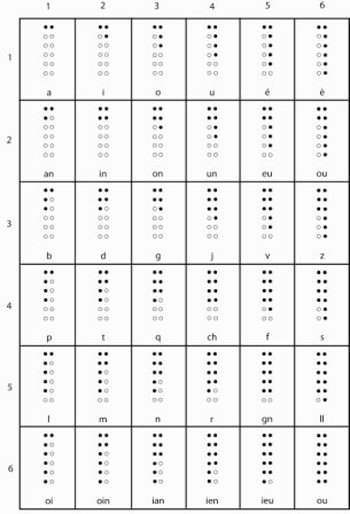As with so much else in our cultural heritage, the origins of braille lie in Ancient Greece. The historian and scholar Polybius invented what became known to cryptographers (code makers) as the Polybius Square, a system for encoding letters using a 5x5 grid.
| 1 | 2 | 3 | 4 | 5 | |
|---|---|---|---|---|---|
| 1 | A | B | C | D | E |
| 2 | F | G | H | I/J | K |
| 3 | L | M | N | O | P |
| 4 | Q | R | S | T | U |
| 5 | V | W | X | Y | Z |
Jump forward a few millennia to the France of Napoleon Bonaparte who wanted his soldiers to be able to communicate silently and in the dark. This led Captain Charles Barbier de la Serre to develop his Ecriture Nocturne (night reading) system. Barbier used a 6x6 grid with raised dots to represent the letters (and some common pairs of letters) of the French alphabet.
 Sonography
Sonography
In 1821 Barbier demonstrated his system at the Institut National des Jeunes Aveugles (Royal Institute for Blind Youth) in Paris and in the audience was the 12-year-old Louis Braille, blind since a childhood accident. Braille had already developed a tactile coding system to enable his blind peers to read and write but recognised both the superior potential of Barbier’s system as well as its shortcomings. (It could take up to 12 dots to encode a single letter and the size of the grid meant it could not easily be scanned by a single finger.) By 1824 Braille had refined a system based on Barbier’s, using an array of dots in a much simpler 6x2 grid. It was first published in 1829, then revised in 1837 and gained international acclaim and acceptance as the standard.
The importance of braille
There is no doubt that braille has had a transformative effect on the lives and life-chances of people with visual impairment. Research has shown that people who learned to read braille as their primary reading medium are more likely to be in employment than those who did not, they are also more likely to have higher educational qualifications and be in more professional occupations. Put simply, the more extensive the braille skills the greater the advantages (Ryles, 1996 - see References below for more information). However, the number of people learning braille has been in steady decline over the last 50 years. The visually impaired population of the UK is currently estimated to be about two million, of these, it is thought that only somewhere between 15,000 and 20,000 use braille. The reasons for this are complex but are probably more related to technological advances than the difficulties of learning braille.
What makes braille difficult?
It has been found that people who have learned to read braille as their original medium do so more easily than those whose visual impairment arises after they have already learned to read print. This may be due to the difficulty they have in developing their tactile skills, not having relied on them for so long. It may also be due to the fact that fewer visually impaired children now attend specialist schools with trained braille teachers and so have less access to intensive and skilled instruction. Age may also be a factor, with respondents to surveys reporting that they believed or had been advised that their age was a barrier to learning braille (Douglas et al., 2006 - see References below for more information). Ultimately, however, the decline is probably ascribable to technological advances in audio and digital technology that provide an alternative way to access text.
What is the future of braille?
It might be thought that the advent of readily available audiobooks and speech recognition software has made braille somewhat redundant. This is not the case. Braille has some practical everyday advantages over audio, (think labelling food tins and medicines) as well as other less tangible attractions: some people simply relish the intellectual challenge of learning braille. Braille also has the advantage that the reader is more in control of the process than with an audiobook and some blind people find the portability and ease of finding your way round a book easier than navigating computer-based technologies.
Computers may yet even save the day for braille, as the recent development of braille display technology begins to take hold. (This blogger gives a very positive view of braille’s future in the world of 21st century technology!). Recent advances in braille display technology allow for the text on the screen of a computer, tablet or smartphone to be transferred to a digital display unit where it is converted into braille by means of arrays of buttons that rise and fall, allowing the visually impaired person to read the text or to compose their own messages in braille that are then sent back to the computer, enabling the user, for example, to register for their next Open University course!
References
- Douglas, G., Franks, J., Weston, A. and Clements, B. (2009) Braille in the 21st Century: opportunities, benefits, and challenges for adults with acquired sight loss. Research Report for the RNIB.
- Ryles, R. (1996) ‘The impact of braille reading skills on employment, income, education and reading habits’, Journal of Visual Impairment and Blindness, May 1, 1996, Vol. 90, Issue 3.
Do you know you can convert any file into Braille with this RoboBraille website?



Rate and Review
Rate this article
Review this article
Log into OpenLearn to leave reviews and join in the conversation.
Article reviews